THE MONGOL INVASIONS OF JAPAN

In the 13th century, Kublai Khan, grandson of Genghis Khan and the Mongol Emperor (Yuan Shi-zu) who founded the Yuan Dynasty of China, envisioned
to succumb Japan and incorporate it as a tributary state of the Mongol empire. In 1274 and 1281 armies were
despatched from the Korean peninsula and China in attempts to land on Japan in today's Fukuoka city area in north Kyushu.
It was so recorded that a thunderstorm harassed north Kyushu island in 1274 when the Mongol (Yuan) army
was fighting, and again in 1281 a typhoon hit north Kyushu island while the Yuan soldiers were on
board their ships preparing for a major landing operation. In both instances the Yuan armies suffered severe
casualties from these natural calamities and the invasions were aborted. These "divine" winds have
come to be known as Kamikaze which, especially during the war periods of pre-1945 Japan, has been fostering
a belief in Japan in the sacredness of the Japanese nation.
After the first invasion of 1274, the Japanese samurai built a stone barrier of 20 km long bordering
the coast of Hakata Bay of today's Fukuoka city. This stone barrier, on which the Japanese soldiers
forcefully fought in resistance, effectively prevented the landing
of the Yuan (Mongol) army on the shore of Hakata (now in Fukuoka city) during the second invasion of
1281.
The Yuan armies were made up of Mongol, Korean and Chinese soldiers.
* * *
Incidentally, when Marco Polo arrived at the capital (today's Beijing) of China in 1275, he was received by
Kublai Khan in his court. For seventeen years Polo remained on the Khan's service in China, until in 1292 when he
left for Europe, returning to Venice in 1295.
First Invasion,
November 1274 |
The Interlude |
Second Invasion,
June-August 1281 |
|
Mainly land battles fought on the coastal strip of today's Fukuoka city.
Yuan army: 40,000; with 900 ships
Japanese army: 10,000
Yuan army used :
probably the first appearance of
bombs
and gunpowder in Japan.
|
1276-1277: Stone barrier built around Hakata Bay.
1275 and 1279: Yuan envoys sent to Japan, but were
executed.
|
Mainly sea battles fought on the coastal waters of northern Kyushu.
Yuan army: 140,000; with 4,400 ships
Japanese army: 40,000
|
Exhibits in the Genko Historical Museum
(Yuan Invaders Historical Museum)
Fukuoka City
 |
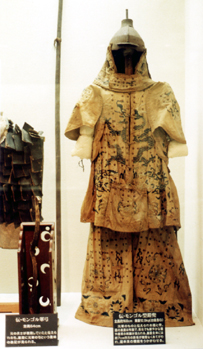
Armour of the Yuan army, weighing 12.5 kg with stand.*
*Whether this is the actual artifact of the period remains to be established.
The entire lining is of small iron plates.
Photo by L Chor, December 1998
|
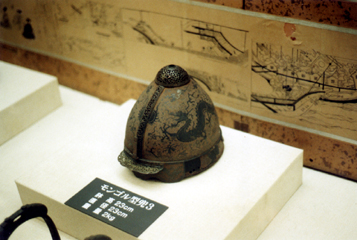
Helmet of the Yuan army, weighing 2 kg.*
*Whether this is the actual artifact of the period remains to be established.
Photo by L Chor, December 1998
|
The stone barrier (200-metre section at Imazu)
Fukuoka City
 |
A scene from
"Mongol Invasions Painting Scrolls"
(Moko shurai ekotoba) |
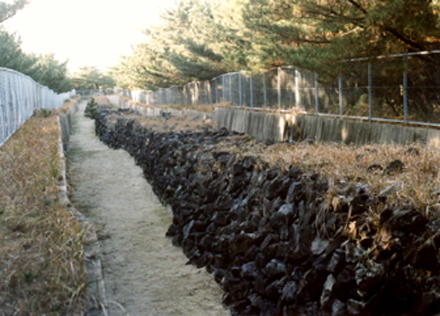
Height about 2-3 metres; width at base about 3 metres.
Built in 1276-1277; excavated in the 1930s.
Photo by L Chor, 30 December 1998
|
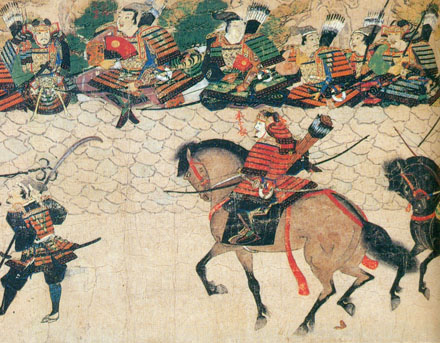
Japanese samurai defending on the stone barrier.
From the narrative picture scroll
Moko shurai ekotoba
painted between 1275 and 1293. |
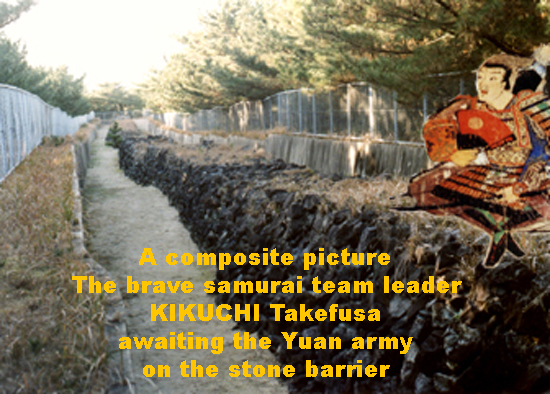
TOP
Return to Bibliography
Return to Front Page


From the Gardener. Canada, September 1999. Revised July 2015.








